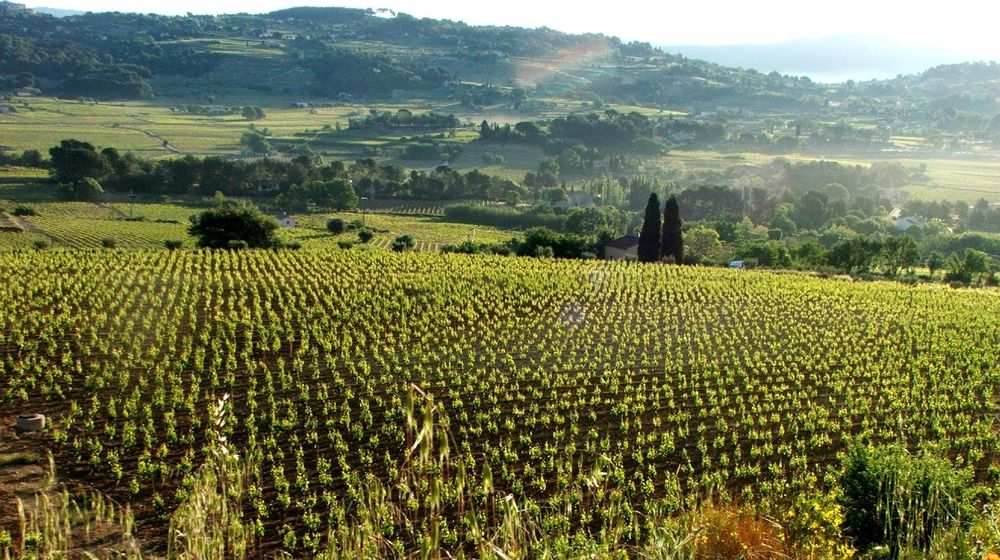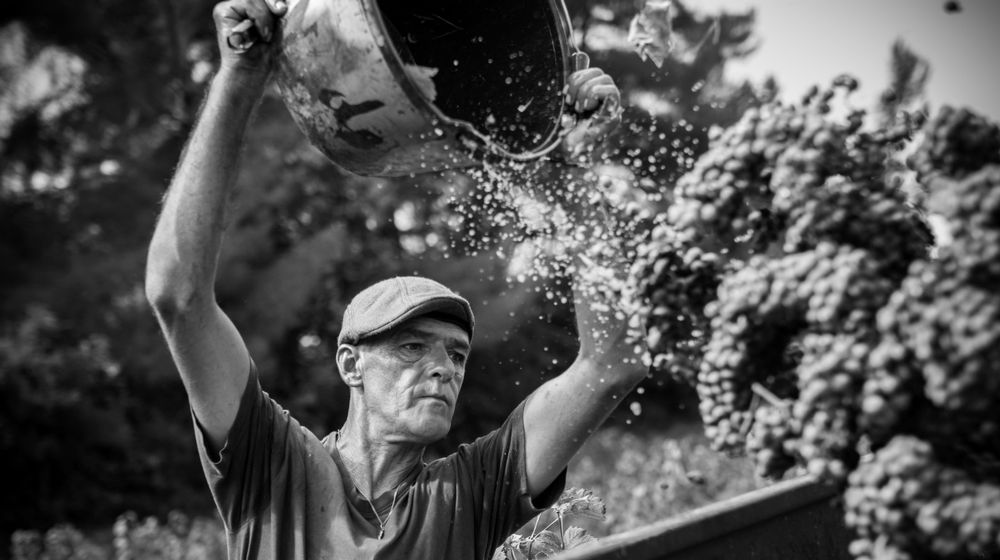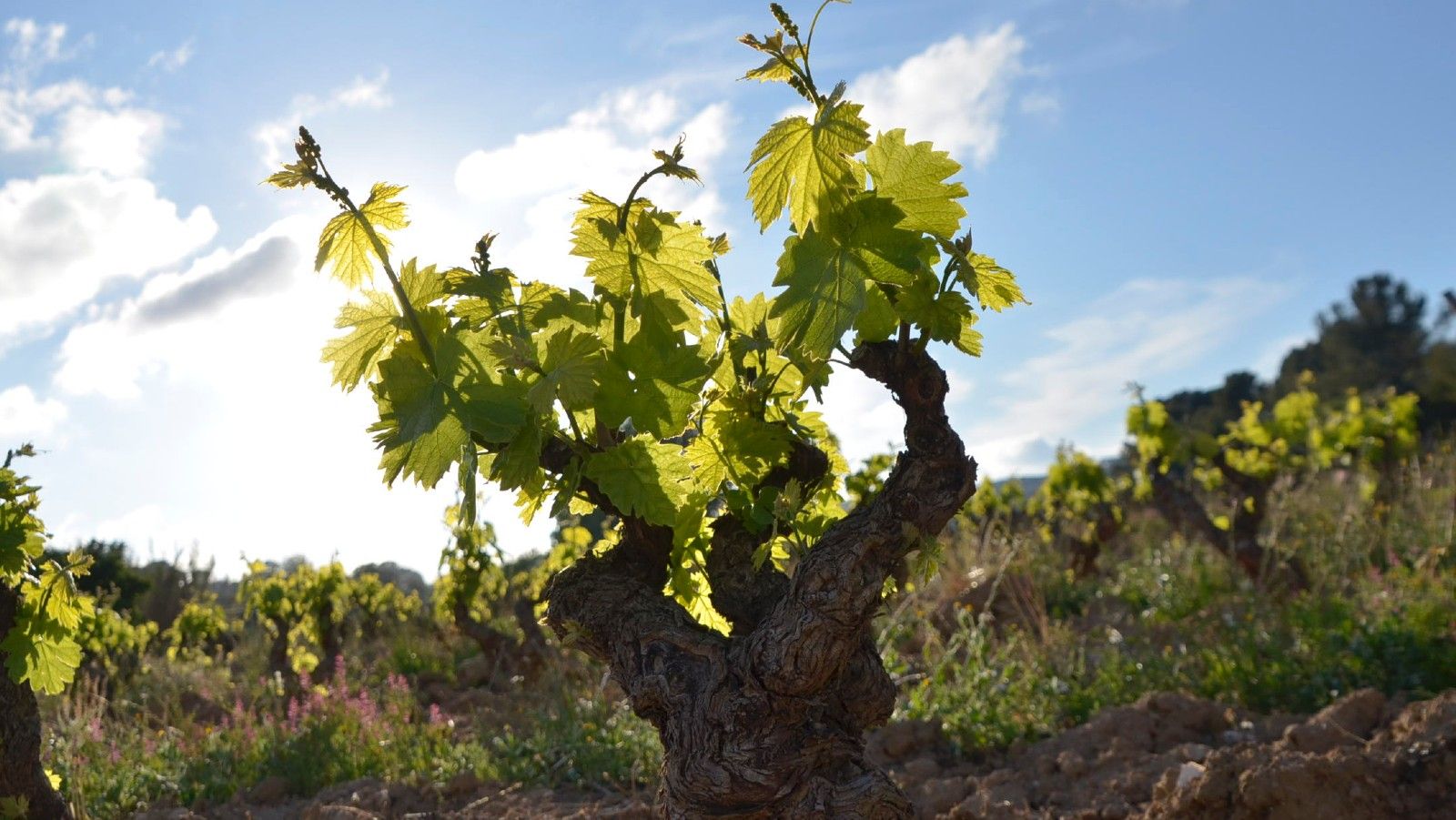“After a couple of years, the reds go through a tight ‘moody adolescent’ phase before charming fruit re-emerges. The 2017s are just starting to show secondary notes,” writes Gabay.
In a tasting of 50 rosé and red Bandol from different vintages, the different ages of Mourvèdre from Bandol are clearly illustrated from youthful rosés to mature reds. (For a full write-up of the latest Bandol rosés click here).

The vineyards of Bandol cover almost 1600ha, in a vast amphitheatre, sloping southwards towards the sea and sheltered by the massif of Sainte Baume (1147m) to the north. The terraced slopes are composed of eroded layers of clay and limestone.
Mourvèdre buds late, a saving grace in the April 2021 frosts which devastated France. It needs a long ripening season, with plenty of heat and light, to fully ripen; winemakers say Mourvèdre needs its head in the sun… but it also needs its feet in the sea, and the maritime winds keep the vineyards moist.
There are many wines which have such an impact on our tasting memory, that their style stays with us forever. Tasting the three Bs – Bordeaux, Bandol and Barolo – back in my early years were big and tannic in youth, almost impenetrable, and needing time to be accessible. Bandol reds are still big and magnificent, but winemaking has developed, and today Bandol reds are very drinkable when very young, supple and structured, fresh acidity and intense fruit, these wines offer charm at all ages.
Still powerful, with beautiful ageing potential, the tannin management has changed. Today the harvest dates are more precise to ensure complete phenolic ripeness, there is a better understanding on extracting and working with the tannins and understanding of working with the barrels for the required 18 months minimum ageing in barrel. The barrels vary from large old foudres to smaller and newer casks. Winemakers look for structure rather than overt oak character and judging from the wines tasted, varying expressions of the Mourvèdre fruit character of black fruit, floral notes and saline notes. Mourvèdre, when ripe, has big ripe tannins, creating structural wines, the longest-lived wines have high percentages of Mourvèdre. Yields are low and hand harvested.
So despite now being in the minority –red Bandol accounts for 25% of the region’s wine compared to 75% rosé – it is still red Bandol which holds the heart and imagination for most wine drinkers, especially those in the wine trade.

2018 – the youngest vintage on the market
Cask samples show youthful vibrancy. Marie Berenice has juicy mulberries, blue floral freshness, inky salinity and tight tannins.
As the wines age, however, more complex notes emerge. The youngest vintage on the market is from the humid 2018 vintage. Bastide de la Ciselette’s Lou Pigna has intense salinity, herbs and cracked black pepper layered with rich bramble jam, blue flowers, smooth tannins and mouth-watering length. Château Vannieres has sweet mulberry, spice and cedar notes, crisp redcurrant acidity, long savoury grip and firm structured tannins. Domaine de la Begude has inky blackberry fruit, scented violets, vibrantly fresh bramble, rhubarb and wild strawberry acidity and mouth-coating grippy tannins. Pierracci has wild raspberries and sour redcurrant acidity, saline minerality and textural tannins. Domaine de la Garenne is multi-layered, with honeyed richness, ripe berries, long, fresh acidity before developing dark berry, black chocolate, coffee and tobacco with powerful tannins. Domaine du Gros Noré has wild, red and inky black berries, garrigue and saline savoury notes with mouth-coating tannins and fresh acidity. La Bastide Blanche has vibrancy, blue violets, perfumed Syrah-like incense, spice and vanilla oak and mineral structure. Château Croix d’Allons has ripe jammy fruit with floral hints, vanilla and spicy oakiness giving supple black chocolate tannins, inky blackberries, crunchy cranberries and a briney finish.
2017 – just starting to ‘grow up’
After a couple of years, the reds go through a tight ‘moody adolescent’ phase before charming fruit re-emerges. The 2017s are just starting to show secondary notes. Gueissard Black Label has big black inky structural fruit, intense mouth-coating, chocolate and coffee tannins, with raisins, figs and long saline freshness. Domaine Terrebrune has smoky, lapsang souchong notes with crushed redcurrants, wild plums, powerful oaky tannins and long fresh acidity. Domaine Dupuy de Lôme has vibrant sour red berries, lively acidity and lovely firm tannins. Château d’Azur’s Jardin du Soleil has deep dark cassis fruit, powerful saline edginess, thyme, fresh acidity and toasty oak structure. Château Canadel’s Altum has ripe cherry jam, leather, coffee, cacao, mouth-watering acidity and fine, elegant tannins. Domaine la Suffrene has black fruit, blue violets, perfumed notes, long, chalky acidity, powerful body and grippy tannins. Château Val d’Arenc has savoury, juicy, blue-black berries and garrigue, fresh acidity and firm, tight inky tannins.
2016 and older
The 2016s were still showing reticence. Les Adrets, Moulin de la Roque had fresh red fruit playing hide and seek behind the intense black chocolate mouth-coating tannins. Château Pradeaux’s Cuvée la Lys has juicy black cherries, parma violets, vibrant redcurrant acidity, cocoa, Christmas spice and powerful mouth-coating tannins.
The 2015s showed complex blends of youthful freshness and the beginning of mature tertiary notes with still powerful structure. La Bastide Blanche’s Cuvée Fontaneou has raspberries, leafy freshness, cracked pepper, black tea, sweet spice and cedar. The tannins are powerful and firm, the acidity vibrant. Domaine Ray Jane’s Cuvée de Falun made with centennial Mourvèdre, has saline smoky notes, crushed strawberries, mouth-coating tannins and fresh length. Domaine le Galantin has juicy, vibrant blueberry and cherry fruit peeping out from behind the sweet and sour oak tannins. Domaine de la Font de Peres has complex layers of moody black cherries, vanilla, cacao, sweet spice and bitter almonds leading on to integrated tannins and balanced acidity.
The cooler 2014 vintage gave extra freshness. Cuvée Speciale, Domaine de l’Olivette has both youthful cranberry and blueberry fruit with the tertiary characters of chocolate, coffee, spice and smoky game, the strong tannins in a supporting role with long acidity. Domaine Vigneret is still very fresh and juicy, with redcurrant and cherry fruit, saline minerality, vibrant freshness and firm black tannins. The Château Ste Anne 2013 has inky black fruit, savoury, garrigue notes, mineral finesse, long fresh chalky acidity, firm ripe tannins and a mouth-watering saline finish. The hallmark freshness and structure continues for many years. Domaine Terrebrune 2011 is elegant with balanced tannins, long, fresh, acidity, violets, minerality, strawberry jam, and a touch of dried fruit.
Mourvèdre, when it reaches full ripeness in the unique Bandol setting, achieves weight, structure and ability to age, developing intriguing combinations of fruit and spice, fresh acidity and weight, which are worth exploring.









































